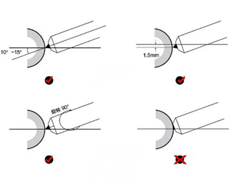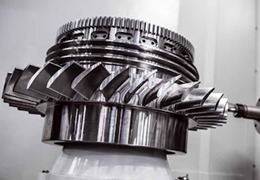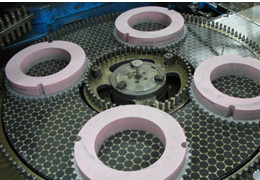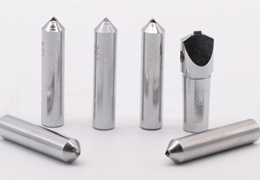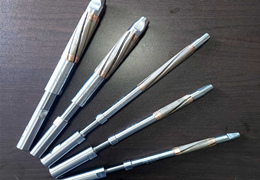Grinding for Lithium Battery Cutting Molds
Lithium battery cutting molds are mainly used to cut aluminum foil and copper foil on the positive and negative electrodes. If there are rough edges, burrs, and other uneven conditions in the cut material of the positive and negative electrodes, it is easy to cause battery short circuits.
Tungsten steel belongs to powder metallurgy steel, which has high hardness and wear resistance. It is commonly used as a raw material for cutting tools. Cobalt is used as a binder to bond and sinter small tungsten carbide particles. The smaller the tungsten carbide particle size, the smaller the fixed area of the cobalt binder, especially at the edges and corners, which are prone to detachment due to grinding and impact.
In-depth exploration of issues:
◆ Heat generated during grinding, resulting in missing corners of the workpiece:
The reason for the missing corners of the workpiece is that in addition to the high hardness of tungsten steel, tungsten carbide particles in the material are prone to detachment at the edges and corners due to impact. The heat generated by grinding dissolves the bonding agent "cobalt" of tungsten steel. When the bonding agent cracks, the particles lose their connection. Once the grinding wheel is ground, it will cause the detachment of tungsten carbide particles, causing edge notches in the workpiece and affecting accuracy.
◆ Grinding wheel thermal expansion, poor dimensional accuracy:
Because the cutting mold requires high-precision grinding in order to make the cutting surface of copper aluminum foil flat, the ideal state is to use fine-grained grinding wheels to remove the abrasive particles bit by bit. However, in reality, due to the heat generated by grinding, both the workpiece and the grinding wheel experience thermal expansion, resulting in excessive cutting volume. The pressure of the grinding wheel on the workpiece increases, which will directly remove the abrasive particles instead of grinding them bit by bit, resulting in notches at the corners of the workpiece.
◆ Difficult to improve surface roughness:
To emphasize surface accuracy, fine-grained grinding wheels are used. However, due to the high hardness of tungsten steel, the speed of abrasive passivation during grinding is very fast. In addition, the cutting force of fine-grained grinding wheels is insufficient, which can easily cause vibration, blockage and heating of the grinding wheel, and reduce surface accuracy.
Common methods for Grinding Lithium Battery Cutting Molds:
◆ Reduce the cutting amount
Mainly temperature control, the most common way to reduce the temperature is to reduce the cutting amount and reduce the pressure of the grinding wheel on the workpiece. Although this method can reduce the grinding temperature, it will reduce efficiency. The same total grinding amount requires more time to reach the goal, which will prolong the grinding time and naturally affect the overall interests of the company.
◆ Use coarser grained grinding wheels
If the second best option is to use a coarser grained grinding wheel, the connection between the abrasives is weak, the resistance to grinding high hardness workpieces is high, and the speed of the grinding wheel's self sharpening is accelerated, which will cause severe sand shedding and easily scratch the surface. The frequency of dressing will also increase.
Solution for Grinding Lithium Battery Cutting Molds:
◆ Grinding wheel with uniform distribution of pores
Based on the above explanation, it can be found that many problems are caused by the grinding temperature. To solve the problem of grinding temperature, a grinding wheel with strong heat dissipation can be selected, and the heat dissipation is closely related to the air holes. The design of air holes is very important in the grinding wheel, and the uniform distribution of air holes can effectively reduce the grinding temperature. However, such design depends on the manufacturer's own technology and quality stability ability. If the production technology is unstable, The air holes in the produced grinding wheel will also be uneven.
◆ High strength inner disc
For the thermal expansion part, in addition to the air holes, the inner disk shall be made of materials with higher strength, such as ceramics. These materials themselves have lower coefficient of thermal expansion, which can avoid excessive cutting of the grinding wheel due to thermal expansion. In addition, the ceramics themselves have the characteristics of impact resistance, which can have more stable grinding results when responding to high hardness workpieces.
◆ High quality and stable trimmer
The surface roughness is closely related to the cutting force of the grinding wheel. After reducing the grinding heat, maintaining good cutting force will make the grinding more stable. Therefore, it is recommended to put more effort into dressing the grinding wheel. Proper dressing can extend the service life of the grinding wheel and maintain good service life and performance. Conversely, it will be easy to sand, consume too quickly, or accelerate the blocking speed.
It is recommended to choose a high-quality and stable dresser, and pay attention to the differences between correction and sharpening. Correction refers to maintaining true roundness of the guide wheel shape, while sharpening refers to removing surface debris and maintaining sharpness. Both actions are indispensable.
Summary of Grinding Lithium Battery Cutting Molds:
Grinding tungsten steel often results in problems of grinding heat and surface roughness that are difficult to improve. We suggest strengthening the heat dissipation and impact resistance of the grinding wheel to reduce excessive cutting and vibration absorption, ensuring good trimming while ensuring high cutting force. This not only maintains the lifespan of the grinding wheel, but also makes the grinding results more stable, ensuring the quality of the products produced.

